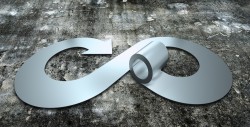Environmental discussions used to focus on lifecycle analysis including recycling at the end of a building's practical life and embodied carbon calculations. But as Steve Thompson, Managing Director of EOS explains, this is only part of the sustainability equation.
Light steel frame construction is used extensively in the UK in a wide range of building applications. The precise nature of the advantages will depend on the application and project specifics. However, there are generally five overriding value benefits – safety, quality, speed, strength and the lightweight yet robust nature of light steel frame construction. These lead to additional advantages, such as reducing concrete foundations, early completion, fewer snags, elimination of shrinkage and minimal re-work.
But the sustainability benefits are often overlooked. In the UK, the Steel Construction Institute (SCI) has produced evidence that we are largely self-sufficient in steel, meaning we can pretty well produce all the steel we need through recycling our latent stock to satisfy market demand.
Manufactured from the most abundant component on earth, steel can be recycled or reused endlessly without detriment to its properties. This unique characteristic gives steel a high value at all stages of its lifecycle. The recovery infrastructure for steel recycling is highly developed and extremely efficient and has been in place for decades. Current recovery rates from demolition sites in the UK are 99% for structural steelwork and 96% for all steel construction products – figures that far exceed those for any other construction material.
Light steel frame is predominantly used for complex buildings where additional structural integrity is necessary and provides the answer to complex questions where a lightweight response is required. Offering the best strength-to-weight ratio improves efficiencies – you get a lot of structure for relatively little weight which reduces embodied carbon. This is where steel cannot be beaten. Lighter structures not only reduce material consumption but also concrete in the ground. This means that foundation loads and sizes are reduced by over 70% relative to concrete and block-work construction.
Site waste is virtually eliminated by the use of prefabricated light steel components compared to the industry average wastage of 10% in construction materials. With cold rolled steel, components are manufactured to length the only waste is the swarf and offcuts produced which are minimal and can be recycled. One thing that is not considered as part of the sustainability equation is the utilisation percentage of steel – all offcuts are recycled and there is no waste at all during the manufacturing process, therefore no production waste.
High levels of thermal insulation and airtightness are achieved in light steel framing. EOS has developed in collaboration with our Etex group partners, Siniat, a leading expert in plasterboard and drylining systems, together with fire protection specialists Promat and FSi – our Thrubuild® complete load-bearing walling and flooring systems. Our components and products are rigorously tested together to ensure compatibility and system performance, enabling us to warrant the technical performance of our Thrubuild® range of solutions and offer a 30-year warranty.
Carbon Calculations
In my opinion we cannot take a short-term embodied carbon 'construction' approach – it is far greater than that. We have to think long-term to mitigate the devastation of climate change and consider the health of our planet for generations to come. But to do this we need to turn to technology to provide full lifecycle carbon analysis from manufacture and construction to in-use together with recycling and reuse at the end of a building's life. Digital value toolkits are required to provide much needed evidence to change the debate and to offer in-depth accurate analysis of whole life carbon calculations.
This whole life approach will be a 'game changer' for light steel framing systems in the sustainability stakes and long-term analysis will show that steel is intrinsically more sustainable than other construction materials. Light steel frame is most definitely part of a carbon neutral solution and communicating this is crucial. Its assets make it the ultimate sustainable construction solution in terms of its longevity, material and recycling properties and importantly, enhancing the safety credentials of steel-framed buildings.
EOS is a leading innovator in the design and manufacture of light gauge steel systems. The EOS product and service range is underpinned by investment in state-of-the-art design and manufacturing technology, coming together to deliver award-winning sustainable steel framing systems across a wide range of construction sectors. For more information and to view video project case studies, insights into our advanced manufacturing processes and client testimonials go to: www.eosframing.co.uk/information-centre/video-vault









